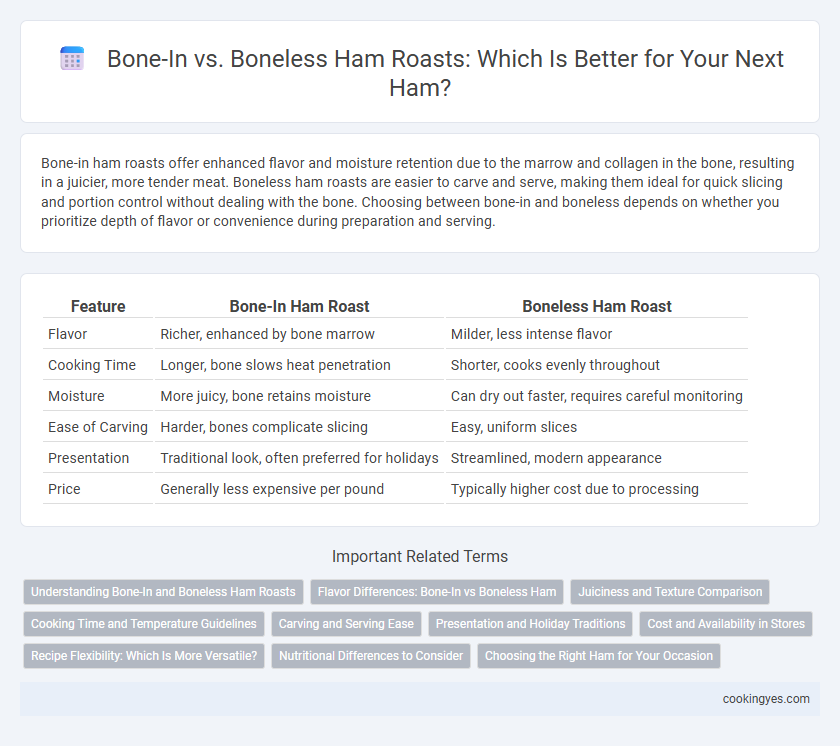Bone-in ham roasts offer enhanced flavor and moisture retention due to the marrow and collagen in the bone, resulting in a juicier, more tender meat. Boneless ham roasts are easier to carve and serve, making them ideal for quick slicing and portion control without dealing with the bone. Choosing between bone-in and boneless depends on whether you prioritize depth of flavor or convenience during preparation and serving.
Table of Comparison
| Feature | Bone-In Ham Roast | Boneless Ham Roast |
|---|---|---|
| Flavor | Richer, enhanced by bone marrow | Milder, less intense flavor |
| Cooking Time | Longer, bone slows heat penetration | Shorter, cooks evenly throughout |
| Moisture | More juicy, bone retains moisture | Can dry out faster, requires careful monitoring |
| Ease of Carving | Harder, bones complicate slicing | Easy, uniform slices |
| Presentation | Traditional look, often preferred for holidays | Streamlined, modern appearance |
| Price | Generally less expensive per pound | Typically higher cost due to processing |
Understanding Bone-In and Boneless Ham Roasts
Bone-in ham roasts retain the natural flavor and moisture from the marrow and surrounding tissues, enhancing the overall taste and juiciness during cooking. Boneless ham roasts offer convenience and uniform slicing, making them ideal for uniform cooking times and easier carving. Selecting between bone-in and boneless depends on the desired texture, cooking method, and presentation preferences.
Flavor Differences: Bone-In vs Boneless Ham
Bone-in ham roasts retain more moisture during cooking, resulting in richer, juicier flavor due to the marrow and connective tissues releasing natural fats and nutrients. Boneless hams offer convenience and consistency, but may lack the depth of flavor that the bone imparts. The bone-in variety often provides a more savory and tender experience, enhancing the overall taste profile of the ham roast.
Juiciness and Texture Comparison
Bone-in ham roasts retain more moisture during cooking, resulting in juicier and more flavorful meat due to the marrow and connective tissues releasing collagen. The texture of bone-in ham tends to be firmer yet tender, providing a satisfying bite that boneless varieties often lack. Boneless ham roasts offer convenience and ease of carving but may sacrifice some of the depth in taste and succulence that the bone imparts.
Cooking Time and Temperature Guidelines
Bone-in ham roasts generally require longer cooking times compared to boneless ham due to the heat conduction properties of the bone, typically needing about 18-20 minutes per pound at 325degF for thorough cooking. Boneless hams cook faster, usually about 15-18 minutes per pound at the same temperature, allowing for more even heat penetration and easier carving. Maintaining an internal temperature of 140degF for fully cooked ham or 160degF for fresh ham ensures safety and optimal texture regardless of bone presence.
Carving and Serving Ease
Bone-in ham roasts maintain moisture and add flavor, making carving more precise as the bone acts as a guide. Boneless hams offer greater ease when slicing, allowing for uniform, thin pieces ideal for serving and presentation. Choosing between bone-in and boneless ham depends on the desired balance between flavor retention and carving convenience.
Presentation and Holiday Traditions
Bone-in ham roasts offer a traditional and visually appealing centerpiece for holiday tables, showcasing a rustic presentation that enhances the festive atmosphere. Boneless hams provide ease of slicing and serving, allowing for a cleaner, more streamlined appearance suitable for buffet-style gatherings. Holiday traditions often favor bone-in hams for their rich flavor and nostalgic value, while boneless options cater to convenience without sacrificing taste.
Cost and Availability in Stores
Bone-in ham roasts typically cost less per pound than boneless options due to lower processing requirements and are more widely available in grocery stores, especially around holidays. Boneless hams offer convenience and easier carving but often carry a higher price and are sometimes limited to specialty or larger retailers. Availability can also vary seasonally, with bone-in hams more commonly stocked for festive occasions.
Recipe Flexibility: Which Is More Versatile?
Bone-in ham roasts offer enhanced flavor and moisture retention, making them ideal for slow cooking or roasting recipes that benefit from richer taste and juiciness. Boneless ham roasts provide greater flexibility in slicing and customization, perfect for recipes requiring uniform pieces or quick preparation such as sandwiches and stir-fries. Choosing between bone-in and boneless depends on desired recipe style, with bone-in favoring traditional cooking methods and boneless suited for convenience and versatile culinary applications.
Nutritional Differences to Consider
Bone-in ham roasts retain minerals such as calcium and phosphorus from the bone, potentially offering slightly higher micronutrient content compared to boneless versions. Boneless ham tends to have a leaner texture with reduced fat content, influencing calorie and saturated fat intake. When selecting between bone-in and boneless ham, consider the marginal nutritional variations alongside flavor and cooking preferences.
Choosing the Right Ham for Your Occasion
Bone-in ham roasts offer enhanced flavor and moisture retention, making them ideal for festive gatherings and traditional meals. Boneless hams provide convenience and ease of slicing, perfect for quick preparation and casual occasions. Selecting the right ham depends on the balance between presentation, taste, and serving style preferred for your event.
Bone-In vs Boneless for Ham Roasts Infographic

 cookingyes.com
cookingyes.com